Are you struggling to retain the information you study? Spending countless hours reading your notes, only to realize that most of it has slipped through the cracks of your memory? Enter active recall - a powerful learning technique that scientific research touts as the most effective way to enhance memory retention. With the active recall learning method, we go beyond passive reading and solidify the information into our long-term memory by engaging our brains in a more challenging, yet rewarding way.
Our expert at Traverse, Dom, has embodied the principles of active recall into our learning platform, creating a space which aids in actively generating answers from memory, reinforcing the knowledge, and enabling learners to grasp the bigger picture, instead of getting lost among isolated facts. And the best part? You can master it in as little as 30 days.
We've put together this comprehensive guide that will help you understand and apply the active recall method effectively. But, if you’re on the hunt for a quick answer about what active recall method is and why it’s so efficient, here’s a snapshot: - Active recall: It involves consciously retrieving information from your memory without any external cues, unlike passive review methods like reading or highlighting notes. This workout for your brain strengthens your ability to remember and retrieve information. - Efficiency: A study involving 118 analyses in cognitive science discovered that active recall was 51% more effective compared to passive review methods. This approach prioritizes long-term memory retention, making it ideal for lifelong learners striving for mastery.

Join us as we embark on this journey of active recall learning, equipping you with the knowledge to transform your learning experience and achieve the desired results. Hold tight as there's a world of efficient learning waiting for you in the coming sections of this guide.
Understanding the Concept of Active Recall
As we navigate the learning landscape, it's essential to understand what active recall truly means. In simple terms, active recall is the act of consciously retrieving information from your memory without any external cues. It's the process of forcing your brain to remember the last thing you've learned or the lessons you've studied thus far. This is the central pillar of the active recall learning method.
The process can be likened to an intense workout session for your brain, where the more you exercise, the stronger your memory becomes. By continuously retrieving the information, your brain works harder, strengthening the neural connections related to the information you're learning.
Difference Between Active Recall and Passive Learning
To appreciate the power of active recall, it's vital to distinguish it from passive learning. Passive learning methods involve simply taking in information in a one-dimensional process. For instance, you might read a textbook, listen to a lecture, or watch an educational video. While these methods are not entirely ineffective, they don't stimulate your brain to actively retrieve and process information.
In contrast, active recall allows for interaction and mastery. It pushes your brain to recall, to process, and to come up with correct answers to questions. This active engagement significantly enhances your ability to remember and retrieve information.
The Science Behind Active Recall
The effectiveness of active recall is not just a theory. It's backed by solid cognitive science. Studies have found that active recall, often referred to as the 'testing effect', is 51% more effective compared to passive review methods. This is because active recall stimulates your brain and reinforces neural connections related to the information you're learning, making it easier to remember in the future.
In essence, active recall is akin to weightlifting for your brain. Just as lifting weights builds and strengthens your muscles, active recall builds and strengthens your neural pathways. The more you use it, the stronger it gets.
At Traverse, we integrate this science-backed approach into our learning tools, ensuring that you get the most out of your learning process.
In the following sections, we'll delve deeper into the active recall study method and share practical techniques you can use to leverage this powerful learning strategy. Stay tuned!
The 3-Step Active Recall Study Method
At Traverse, we believe in the power of the active recall study method and we're keen to share it with you. This is a simple yet extremely effective way to enhance your learning and retention. Let's break down the steps:
Familiarizing Yourself with the Material
The first step is to get acquainted with the content you wish to learn. This could be a chapter from a textbook, a lecture video, or even some flashcards that you've prepared yourself. Spend some time understanding the material, making notes if necessary, and getting a grasp of the core concepts. Remember, the aim at this stage is not to memorize, but to understand.
Actively Recalling the Information
Here comes the pivotal part of the active recall learning method. Once you've familiarized yourself with the material, put everything away and try to recall what you've just learned. This is a critical step that separates active recall from passive learning. Instead of simply re-reading the information, you're forcing your brain to retrieve the information from memory. This active engagement strengthens the neural connections in your brain, making the information easier to remember in the long term.
Checking the Accuracy of Your Recall
The final step of this method is to verify the accuracy of your recall. This could be done by looking back at your source material, testing yourself with flashcards, or even explaining the concept to someone else. This check allows you to identify any gaps in your understanding and correct them right away.
As Dom, the founder of Traverse, explains, "This three-step active recall method is not just about memorizing information, but about deepening your understanding and strengthening your ability to retrieve information when you need it."
Remember, the goal is to make the information stick in your memory and be readily available when you need it. This is why at Traverse, we've developed our learning tools around the principles of active recall, helping you unleash your learning potential.
In the next section, we'll look at some effective techniques you can use to incorporate active recall into your study routine. So, stay tuned!
Effective Active Recall Techniques
Now that we've established the importance of active recall in learning, let's delve into some practical techniques you can use to make this learning method a regular part of your study routine.
Using Flashcards for Active Recall
One of the simplest and most effective ways to incorporate active recall into your study routine is by using flashcards. At Traverse, we're big fans of this method! The process is simple yet strategic - on one side of a flashcard, write a question that relates to the information you're studying. On the other side, write the answer. This structure forces you to engage in active recall as you attempt to remember the answer without looking at it first.
Digital flashcards take this method to the next level by allowing you to incorporate spaced repetition, giving your brain the perfect workout to strengthen memory connections.
Incorporating Quizzes and Self-Testing
Another effective technique for leveraging active recall is through quizzes and self-testing. This method goes beyond rote memorization by challenging you to apply your knowledge in different contexts. Practice tests and questions banks are excellent resources for this, as they often closely resemble the format of final exam questions, making your study sessions more efficient and effective.
Utilizing the Feynman Technique
Named after the Nobel laureate physicist Richard Feynman, the Feynman technique is all about teaching. The premise is simple: if you can't explain it simply, you don't understand it well enough. It's an excellent approach to active recall as it forces you to retrieve information and present it in a clear and concise manner. You don't need an audience for this - explaining the concept to a cat, a potted plant, or an imaginary student works just as well.
Applying the SQ3R Method
The SQ3R method - Survey, Question, Read, Retrieve, and Review - is a systematic approach to learning that promotes active recall. The idea is to first survey the material to get a general idea of the topic, form questions that the text might answer, actively read the text to answer these questions, recall the information learned, and then review the material. By actively engaging with the material in this way, you're not just passively reading the information, but actively recalling it, which strengthens your memory and improves retention.
Mastering the active recall learning method might seem challenging at first, but with these techniques and consistent practice, it's an achievable goal. The key is to find what works best for you and stick with it. As you use these techniques over the next 30 days, we're confident you'll see a significant improvement in your learning efficiency and retention.
How to Use Traverse App for Active Recall Learning
Traverse is a powerful tool designed to aid in the active recall learning method. It incorporates various techniques, including mind mapping, spaced repetition flashcards, and connected note-taking. All of these elements work synergistically to create an effective, efficient, and enjoyable learning experience.
Creating Mind Maps for Active Recall
To start, let's talk about mind maps. At Traverse, we believe that the brain doesn't think linearly, so why should your notes be linear? To reflect the brain's natural wiring, Traverse provides an infinite mind map for you to organize your ideas. You can create nodes of information and link them to reflect the relationships and connections between different pieces of information. This visualization process is a powerful active recall technique, as it forces you to actively think about the relationships and connections between different pieces of information, further ingraining it into your memory.

Using Spaced Repetition Flashcards
Next, we have spaced repetition flashcards, a scientifically validated technique that's incorporated into the design of the Traverse app. These flashcards reinforce your memory just as it's about to fade, solidifying your learning and ensuring long-term retention. You can create smart flashcards that help you review any item just when you're about to forget it. The app schedules your flashcards review based on your previous performance, ensuring an optimal learning schedule tailored to your individual needs.

Connected Note-Taking for Active Recall
Finally, Traverse offers a connected note-taking feature that allows you to jot down your thoughts and observations as you learn. This promotes active learning, which is known to significantly increase comprehension and recall. It's like having a conversation with yourself about the material, which forces you to actively engage with the information, rather than just passively reading it.

In conclusion, Traverse is an excellent tool for implementing the active recall learning method. It combines the best of cognitive science and cutting-edge technology to provide a robust platform for learning. With consistent use, Traverse will not only improve your active recall but also make your learning experience more enjoyable and less overwhelming. Now, you are ready to master active recall in 30 days using Traverse.
Tips for Maximizing the Effectiveness of Active Recall
Now that you've grasped the concept of active recall and learned how to use the Traverse app for active recall learning, let's delve into some strategies to maximize its effectiveness.
Consistent Practice Over Time
Active recall doesn't work like magic. It requires consistent practice over time. It's not so much about the quantity of time spent studying, but rather the quality and regularity of your study sessions. Just like physical exercise, consistency is key in active recall learning. By incorporating active recall into your daily study routine, you will gradually strengthen your memory connections, making information retrieval easier over time.
Avoiding Cramming Before Tests
The active recall learning method shines a spotlight on the inefficiency of cramming. Cramming might help you remember information for a short period, but it's not effective for long-term memory retention. The goal of active recall is to embed information into your long-term memory, so it's accessible when you need it. Instead of cramming, break down your study material into manageable bits and spread your study sessions over time. This approach, known as spaced repetition, is a powerful way to enhance the effectiveness of active recall.
Incorporating Practice Questions and Past Exams
One of the most effective ways to use active recall is through practice questions and past exams. These resources present an excellent opportunity to put your brain to the test and commit things to memory. Practice questions and past exams allow you to simulate a test environment, which can help you become more comfortable with recalling information under pressure. As Dom, the founder of Traverse, explains, "The objective isn’t to get everything right — it’s to get your brain used to the process of retrieving that information."
Teaching Someone Else the Material
One of the most effective ways to reinforce what you've learned is to teach it to someone else. This process is a classic example of active recall. By explaining a concept to someone else, you're forced to retrieve and organize the information in your memory. As the saying goes, "To teach is to learn twice." So, don’t hesitate to share your knowledge with others. It’s a win-win situation: you deepen your understanding and improve your memory recall, and they learn something new.
In summary, active recall is a powerful and science-backed learning strategy. By incorporating these tips and leveraging the features of the Traverse app, you can master the active recall learning method in just 30 days, boosting your memory and making your learning journey more effective and rewarding. Remember, the key to successful active recall is consistency and practice. So, don’t wait, start today and see the difference active recall can make in your studies.
Conclusion: The Power of Active Recall for Learning
Whether you're learning Mandarin, preparing for an exam, or simply expanding your knowledge base, mastering the active recall learning method can revolutionize your learning journey. As we've explored in this article, active recall is a science-backed strategy that can significantly enhance your memory retention and overall learning efficiency.
Active recall involves actively forcing your brain to retrieve information, a process that strengthens your memory connections and promotes long-term retention. Unlike passive learning methods, which involve one-dimensional intake of information, active recall fosters interaction and mastery, compelling your brain to process and come up with correct answers to questions.
Not only is active recall 51% more effective than passive methods, but it's also a flexible strategy that can be tailored to your unique learning needs. Techniques such as using flashcards, self-testing, or even creating mind maps on our Traverse app can support your active recall practice.
Remember, as Dom, the founder of Traverse, often emphasizes, consistency is key when it comes to active recall. Regular practice, spaced repetition, and active engagement with the material are all fundamental components of this powerful learning method.
Active recall may be a bit more challenging than passive learning, but much like a rigorous workout for your physical muscles, it's the challenge that builds the strength of your 'brain muscle.' The more you exercise it, the stronger and more efficient it becomes.

As you embark on your active recall journey, remember that it's a marathon, not a sprint. It may take time to see significant changes, but rest assured that each active recall session is a step towards enhanced learning.
So why wait? Start harnessing the power of the active recall learning method today, and experience the transformation in your learning journey. At Traverse, we're here to support you every step of the way, providing you with the tools and techniques to optimize your learning experience.
In the words of Benjamin Franklin, "An investment in knowledge pays the best interest." So invest in your knowledge with active recall, and reap the rewards of effective, efficient learning.

